
I spent most of the day gardening, shopping for produce at the country store out in Fontana, buying some more herbs and a cute little succulent to plant in the garden, and working on the computer.
And, I ordered 3 CDs from Amazon. I've been feeling a bit starved for new music lately, so I got these:

Satie's piano music has a strange charm that can't be improved, so the idea of setting it for a jazz trio (piano, bass, drums) sounds a bit obnoxious — but when I heard the above samples on National Public Radio, I actually liked them! It's especially intriguing when the rhythm of a piano piece you know well is tampered with a bit. Again I'm a bit scared that I'll be disappointed by this music: maybe it will sound worse in large quantities than in tiny snippets. But, I decided to take a risk. At the worst, it should make acceptable background music.
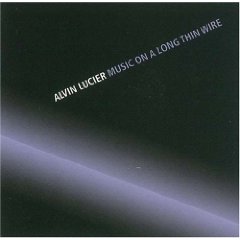
I heard someone raving about this in some list of the 20 best pieces of modern music. It sounds intriguing, since I like ultra-minimalist music and explorations of texture:
A 50 foot length of taut wire passes through the poles of a large magnet and is driven by an oscillator; the vibrations of the wire are miked at either end, amplified and broadcast in stereo. The thin wire is set vibrating four times at four different frequencies; what results is not the low drone one might expect from a long, vibrating wire, but a complexity of evocative, ethereal chords. First released on Lovely Music in 1980, Music on a Long Thin Wire is a classic example of Alvin Lucier's investigations into the physics of sound and the sonic properties of natural processes.
Block is an expert on Lie algebras, and there's a fun story about him and Murray Gell-Mann, the physicists who one the Nobel prize for inventing "quarks". Actually quarks were part of a mathematical scheme which Gell-Mann called the Eightfold Way, because it was based on the 8-dimensional Lie algebra su(3).
The story goes like this:
Murray Gell-Mann's dream was to find a Lie algebra whose representations could model the observed baryons and mesons. A long time ago Heisenberg had invented a theory like this based on the Lie algebra su(2). This was able to account for baryons and mesons known at the time, but a lot more were discovered later. Gell-Mann knew this Lie algebra should contain the 3-dimensional Lie algebra su(2), since he wanted his theory to include Heisenberg's. In 1960 he worked on this problem for 6 months. He tried inventing 4-dimensional Lie algebras, then 5-dimensional ones, then 6-dimensional ones, then 7-dimensional ones... and gave up in disgust at this point, since nothing worked.
Then he talked to Richard Block, who is now a emeritus professor here at UCR, but was then an assistant professor at Caltech. Block told Gell-Mann that he'd been reinventing the wheel, and not doing a great job of it either: Élie Cartan had classified simple Lie algebras a long time ago, and after su(2) the smallest one is 8-dimensional, namely su(3).
Gell-Mann then invented the Eightfold Way.
I think that at the time, only 7 of the particles in the "meson octet" were known. The Eightfold Way said there should be 8, because su(3) is 8-dimensional. The missing meson — the eta — was discovered later:
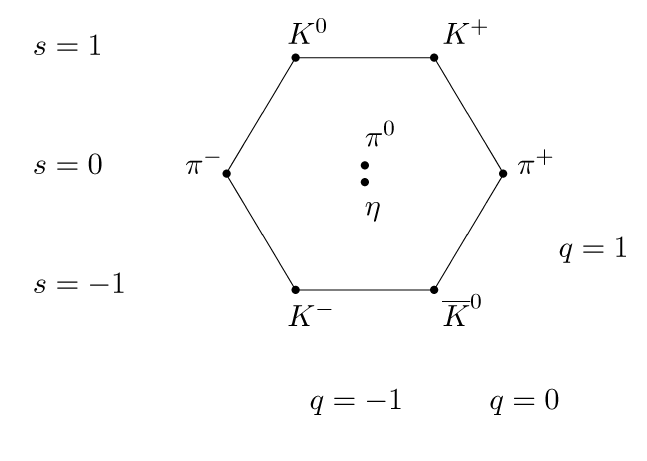
Here q stands for electric charge and s stands for strangeness — the new ingredient in Gell-Mann's scheme.
I believe all 8 particles in the "baryon octet" were known at that time, too:
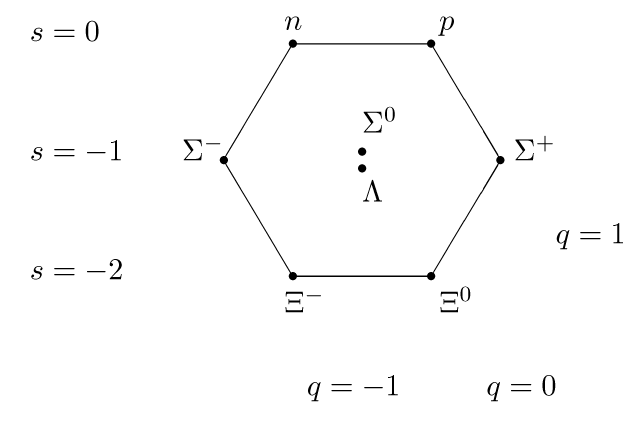
Only 4 particles in the baryon decuplet were known: the Δ-, Δ0, Δ+ and Δ++:
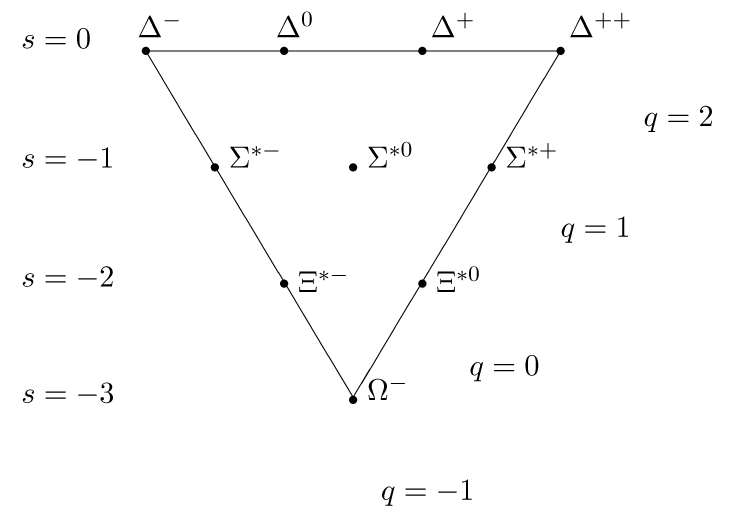
This left only one missing!
So, Gell-Mann got up, went to the microphone, and predicted the existence and properties of the last one.
He called this one the Ω-, since omega is the last letter of the Greek alphabet.
The Ω- was discovered by Samios and Palmer in 1964. It had just the properties Gell-Mann had predicted, so he won the Nobel prize in 1969.
Richard Block was also the first to write anything about what's now called the Virasoro algebra — a Lie algebra that plays a key role in string theory.
But now Richard Block is retired. He spends a lot of time in his beautiful home up in the hills behind the U.C. Riverside campus, sometimes working on math, sometimes fighting the developers who are trying to buy up every tiny parcel of land in this town and build a McMansion on it. Since a lot of the city council is in bed with the developers — indeed, some of them are developers — this is quite a battle. Recently a 90-year-old woman was ejected from a city council meeting — escorted away by cops! — for asking questions about what was going on.
Richard's wife Jane Block is even more active in this battle. They're both part of a group called Friends of the Hills of Riverside.
At his birthday dinner, Richard recounted the tale of some developers who had cleverly tried to measure the size of a lot from the middle of the road instead of from the sidewalk, so they could put a bigger house on it. When the Friends of the Hills of Riverside filed a complaint, they were informed that now there's $1080 fee to file a complaint! They paid the fee... and were informed that there was a precedent for this action, because it's been done twice before. The fight isn't over yet.
I realized that people like this — older people who've been in a community for decades, know all the movers and shakers, and have the energy for politics — can make a huge difference in the daily life of a town. There are lots of parks in Riverside that owe their existence to the Friends of the Hills of Riverside and the UCR Neighborhood Association — another group, currently run by Gurumantra Khalsa, who with his wife was also at Richard Block's party. I tend to have little time for this sort of thing, but maybe I should. Or maybe I should leave it to those who enjoy it.
I met another member of Friends of the Hills of Riverside at Richard's party: Leonard Nunney, a population biologist here at U. C. Riverside. Cool guy!
And, I found out about a great book, a guide to local plants, which
should be available for purchase at an open house this weekend.
More on that later, I hope.
March 9, 2007
What's this?
Take a guess; then look at the September 6th Astronomy Picture of the Day.
Today's Seminar About Long Term Thinking touches on a theme I'm obsessed by lately:
Here's Kevin Kelly's summary of Fagan's talk:
There are two kinds of historians, Brian Fagan says, parachutists and truffle hunters. Parachutists command an overview of the landscape, while truffle hunters dig deeply to uncover marvelous treasures. Fagan is a parachutist. In his talk Fagan emphasized a wide view of human history as it unrolls in the landscape of climate. In our lookout from the parachute, we can see evidence from ice cores, tree rings, fossil pollen, and historical records, all pointing to the conclusion that people in the past have suffered through global warming periods before.So what happens?
Using data from truffle-hunting historians, Fagan told of how vineyard harvest records in Europe show that England became so warm during the period between 800-1250 AD that England not only had vineyards in its central provinces but it also exported wine to France. The medieval warm period had repercussions throughout society. Iceland and Scandinavia warmed up enough to grow cereal crops, tree lines elevated in mountain areas, and there were longer growing seasons everywhere on the continent.
This warming up of agriculture initiated the first vast clear-cutting of European forests. In the short 200 years between 1100 and 1300, from one-third to one-half of European wooded wilderness was deforested to make way for fields and pastures — shaping the lovely farm scenes we now associate with Europe. (Today only Poland has any remaining virgin forests).
Fagan says the myth of the medieval warm period is that it was warm. There were all kinds of weather extremes. In 1315 it started to rain for seven years. The newly cleared and naked hills eroded, dams burst, disease spread, and prolonged drought followed.
And not just in Europe. Mesoamerica was jolted by long droughts. The Mayan pyramids at Tikal were engineered to act as water collection reservoirs. The collapse of their empire, and others in South America such as the Inca in Peru, are correlated to prolonged droughts.
Indeed, says Fagan, the elephant in the climate room is drought. As recently as the 1800s, prolonged droughts killed 20-30 million people in India during the British Raj period. We have a tendency to believe that modern technology has alleviated our susceptibility to drought, and it has — except for the billions of people on earth today who are living as subsistence farmers.
It is upon these people that Fagan wanted us to focus our attention and care, because it is upon these people that the most serious consequences of global warming will fall. Referring to his own experience of many years as an archeologist in Africa, he painted a vivid image of what a severe drought entails and how a drought can act like a cascading disruption and rapidly destroy a vibrant culture to the point where it disappears completely.
Forget the rocketing "hockey stick" of global warming, he urges. Even mild climate warming produces prolonged droughts, and we should expect more of them. There's already been a 25% increase in droughts globally since 1990. In the next 100 years, we can expect the number of people to be affected by droughts to rise from 3% of the world's population to 30%.
The lesson Fagan wanted us to leave with was that the effects of global warming will be felt greatest on marginal land and marginal peoples — many far from the sea and rising sea levels — and that because of their marginality, the consequences of prolonged drought will not just be inconvenient, but devastating.
In the question and answer period, he was asked what the stricken people can do about it? "Move," he said, "is the only option." If the world is heating up, where would he move to? "Canada. It will be dryer, much warmer, and their politics are reasonable."
Unfortunately, the process of buying the car took longer than expected,
so we were late in meeting our house guest, the mathematician Eugenia Cheng.
March 13, 2007
Speaking of drought, the one here keeps getting worse:
It's August in March for Fire Agencies
Hector Becerra and Andrew Blankstein, Times Staff Writers
Los Angeles Times
March 13, 2007As Southern California endures its driest 12 months on record, firefighters are dealing with something new: the yearlong fire season.
The region has not experienced a major rainstorm in nearly a year, with downtown Los Angeles recording just 2.42 inches of rain this season, more than nine inches below normal.
The dry conditions are taking their toll.
The Santa Ana winds that usually roar from October through December have continued with unusual frequency into March, helping fuel fires over the weekend in Orange and Riverside counties as well as smaller blazes Monday near the Griffith Observatory and in Agoura Hills.
Cities across Southern California, including Los Angeles, Westwood, Burbank, San Gabriel, Long Beach, Riverside, Oxnard and Laguna Beach, all set new temperature records Monday, ranging from the mid-80s to the mid-90s.
Local agencies have responded by beefing up fire staffing, treating late winter like the late summer and fall fire season.
"You count on winter and spring as being a respite, a time to regroup, to heal and prepare for the upcoming fire season," said Tim Sappok, the assistant operations chief for the San Bernardino County Fire Department. "Now, normal is abnormal. We aren't seeing the seasonal cycle. We have fuels that are ready to burn. It looks like midsummer, vegetation-wise."
The deep freeze that hit much of the region in January is also worrying firefighters because it killed or damaged countless trees and plants, leaving them vulnerable to fire.
"I know what I see, and I see a lot of things that are not good," said L.A. County Fire Capt. Bob Goldman, who responded to an unseasonal January brush fire in Malibu that destroyed five homes. "You see the lack of tall green grass, the lack of mustard plants growing. I am not seeing any of that. There is no water to get things going."
The dry conditions have residents in fire-prone areas on edge, especially as they look ahead to summer and fall, when the heaviest Santa Ana winds kick in.
Jan Currey, who has lived in Malibu for 23 years, said fires in her area usually start to the east and move west, giving people time to react. But the dry conditions have made even coastal neighborhoods vulnerable, as the January fire on the beach showed. She and her neighbors are bracing themselves.
"I've been here long enough to see patterns," Currey said, "and that if it's dry and windy, it's much worse for fires."
But fire experts said Malibu and other coastal hillside regions up and down the Southern California coast are actually in better shape than other places because they have gotten relatively more rain.
As the hot, dry conditions extend into summer, L.A. County Fire Assistant Chief John Todd said, he is most worried about the foothills and mountains along the San Gabriel Valley, which have received less rain, leaving the grass and shrubs with a much lower moisture level.
"We have areas of L.A. County that are rapidly drying out," Todd said. "Maybe we can get a week or two of actual winter. The thing we don't know is what May and June are going to do. Are we going to get May gray and June gloom? It doesn't seem possible right now."
Officials in Orange, Riverside and San Bernardino counties share those concerns, noting that rainfall along inland hillsides and mountain ranges is far below normal.
Consider what Orange County fire investigators found when they examined the brush Monday around the Anaheim Hills wildfire, which burned more than 2,000 acres.
George Ewan, a fire-defense planner for the Orange County Fire Authority, said the moisture levels in vegetation revealed that most of the plants lingered on the brink of death. The vegetation tested looked as if it had been plucked at the end of a long, dry summer.
"If this is the beginning, I don't know where we're going to end up," he said.
Bonnie Bartling, a weather specialist for the National Weather Service in Oxnard, said the forecast does not call for rain in the foreseeable future.
[....]
This day was different, because Eugenia Cheng was there the whole time. She joined in, and it was a lot of fun.
Tonight there was a dinner for Mike Stay: he's leaving town this weekend to take a job at Google. It's sad to see him go, but it'll be good for him. I hope we keep working on our projects.
At dinner I heard for the first time of the bizarre game of
Eton Fives.
I'll let you read about it yourself!
March 16, 2007
A retired CEO of Lockheed recently led a National Academies group
that prepared a report about the problems with education in the
United States, and their economic effects. Here's the report:
Underlying the group’s findings is a trend referred to by journalist and economist Frances Cairncross as “the death of distance,” a phenomenon having its roots in science and engineering. Its essence is that parties to many transactions no longer need to be in close physical proximity to one another. For example, visitors to one commercial office building near the White House are greeted by a receptionist appearing on a flat-screen display — but she is actually in Pakistan. Similarly, in many U.S. hospitals, patients’ CAT scans are read by doctors in Australia or India. A surgeon in New York not long ago removed a patient’s gallbladder in France, using a robot. Many Americans, perhaps unknowingly, had their income taxes prepared last year by accountants in Costa Rica. I was recently provided over my cell phone very accurate real-time driving directions to a building near Washington, D.C., by a gentleman in Bangalore. And we are all familiar with call centers in India, where they now offer courses in speaking English with a Midwestern accent.At the National Academies website I bumped into something about the widespread dieoff of bees, a topic I wrote about last November 5th:What this means to many Americans is that qualified candidates for the jobs they would like to hold are now located all around the world, just a mouse-click away. Furthermore, these candidates — whose numbers swelled by 3 billion after the demise of fundamental Communism — are willing to work for a fraction of the pay to which most Americans have become accustomed, are highly motivated, and are increasingly well educated. I recently visited a factory in Vietnam where 20 assembly workers could be hired for the cost of one in the United States. Six engineers can be hired in India for the cost of one in the United States; five chemists can be hired in China for the cost of one American.
Exacerbating basic wage scales are asymmetries in benefits and other costs; for example, General Motors now spends more on health care for its employees and retirees than on steel; Starbucks more on health care than on coffee; and U.S. industry as a whole more on litigation than on research and development.
The body of evidence regarding the impact of such developments is growing daily. For example:
• Seventy-seven percent of currently planned new research-and-development facilities in the world are to be located in India or China.
• IBM not long ago sold its personal-computer business to a Chinese firm.
• The remnants of what was once America’s greatest industrial research institution, the legendary Bell Labs, recently were sold to a French company.
• General Motors and Ford both have junk-bond ratings. In the last five years they have laid off more than one-third of their North American workforces.
• Toyota’s market capitalization is more than six times that of Ford and General Motors combined.
• Only one of the 25 largest initial public offerings last year occurred in the United States.
• Bethlehem Steel celebrated its 100th birthday in 2000 by declaring bankruptcy, with its number of employees having dropped by a factor of 14 down to 12,000 — but with 90,000 pensioners seeking benefits.
• The U.S. share of leading-edge semiconductors dropped from 36 percent to 14 percent in the last six years.
• Only three U.S. companies are in the top 10 receiving U.S. patents.
• In just a decade, the U.S. trade balance in high-tech goods and services switched from a positive $50 billion to a negative $50 billion.
Given such evidence, the unanimous answer of the National Academies committee members to the question, “How well are Americans going to be able to compete for jobs in the years ahead?” was a resounding: “Not well.” The highest priority for attention, in the view of the committee, is the substandard quality of K-12 public education in America. Microsoft’s Bill Gates put it this way: “When I compare our high schools to what I see when I’m traveling abroad, I’m terrified for our workforce of tomorrow.” Former Federal Reserve Chairman Alan Greenspan punctuated that notion, observing, “If you don’t solve the (K-12 education) problem, nothing else is going to matter all that much.”
It is, of course, a good thing that other nations are prospering; the National Academies would like for America to continue to be among that group.
Across the United States, beekeepers are reporting a loss of 30 percent to more than 70 percent of overall beehives. Experts are calling it "colony collapse disorder," in which bees have started leaving their hives in droves, never to return. They think the phenomenon is tied to recent stresses on the bees.Our garden is recovering from its near-death during last summer's hot spell, and it's becoming a bee paradise again. If you go in our back yard you'll see lots of bees hovering around the wisteria blossoms — but also lots of bees drinking from the fountain. They practically line up there to drink!

Another interesting article in the normally dull Princeton Alumni Weekly concerns the research of sociologist Katherine Newman on the working poor, and psychologist Eldar Shafir on the way real people make economic decisions:
According to Shafir, factors such as hassle or embarrassment can appear inconsequential in standard economic cost-benefit analyses — but they deter people in important ways. One example is the recent debacle over Medicare Part D: Many senior citizens found the choices too difficult to make. "If you talk to the policy-makers, they recognize that facing lots of options is confusing, but feel confident that people will ultimately focus on the important details and make their decisions," he says. Instead, Shafir has found that feeling hassled or conflicted can deter people from making any decision. Similarly, Shafir and his colleagues have observed that residents of low-income neighborhoods often pay more to process checks from local check-cashing services rather than open bank accounts where they might have to navigate an intimidating, unwelcoming, and complicated system. They might patronize a business with more personalized service — even if it costs more &mdash to avoid the "condescension, suspiciousness, or uncertainty offered by many institutions," he says.This is not news, but I'm glad someone is finally studying it systematically, instead of idealizing it out of existence!
The news in this diary may seem a bit depressing, but I'm actually
happy about a sea change that occurred in the U.S. over the last year.
People are starting to
take global warming seriously, getting sick of their petroleum
dependence, and seeing through the propaganda cloud of the Bush
administration regarding these and other issues, including the Iraq
war. Whether it's happening in time remains an open question —
we'll see.
March 19, 2007
I had fun
blogging about a rather hyped
calculation involving the
Lie group E8, trying to get some details out while
everyone else was still scratching their heads over the vague accounts
in the popular media. I had the advantage that someone at the
American Insitute of Mathematics told me about
their website a few days before
the press embargo was lifted.
Later I wrote some more about E8 in
week247 of This Week's Finds,
using it as a fun way to kick off what I hope will be a long series
about the work James Dolan, Todd Trimble and I have been doing on
"groupoidification" — a mammoth project unifying all
sorts of ideas on symmetry, geometry and logic.
March 20, 2007
My mother called Lisa on her cell phone while we were driving home
from shopping. She never does this, usually. She said she had some
news for me. I was driving, so I didn't want to talk on the phone...
so Lisa said I'd call her back when I got home.
I started worrying that something had happened to my father – did he fall again? Did he have a stroke? Did he die?
It turned out my father's brother, Albert Baez, had died. He was the one who got me interested in physics in the first place — since his specialty was physics education, he would always come to town with lasers, holographs, diffraction gratings and the like. I especially liked the green corrugated plastic tubes you could whirl over your head to make sounds — different harmonics illustrating the physics of standing waves. This was an example of his interest in low-budget physics education suitable for third-world countries. (That's what they called them then.)
When I was eight he gave me his college physics textbook, The New College Physics: A Spiral Approach. I remember staring fascinated at the hand-drawn pictures. Later that's where my interest in particle physics started.
He had the first electronic calculator I ever saw. He gave me Silvanus P. Thompson's classic Calculus Made Easy, and that's how I learned calculus. He gave me Feynman's Lectures on Physics, and that's how I learned quantum mechanics, the summer of my junior year of high school, when I was working at a job building trails at a state park, living in a trailer with 9 other guys.
He had a huge effect on my life! And, he was a really cool guy. You can just see it:
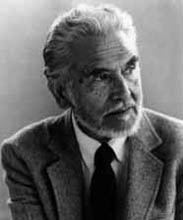
For the last year, though, he's been very sick, often bed-ridden, and suffering an almost complete breakdown of his short-term memory. So, my sorrow — and horror — were largely exhausted already.
It rained a bit tonight... just a tiny bit, but
we need all the rain we can get.
March 23, 2007
Albert V. Baez, 94; physicist and father of Joan Baez, Mimi Fariña
By Valerie J. Nelson
Los Angeles Times Staff Writer
March 23, 2007Albert V. Baez, a physicist who did pioneering work with X-rays and who was the father of folk singers Joan Baez and the late Mimi Fariña, has died. He was 94.
Baez, who also worked to improve science education worldwide, died of natural causes Tuesday in an elder-care facility in Redwood City, Calif., his family announced.
"In all aspects of his life, he combined personal and professional roles as scientist, environmentalist, teacher and humanitarian," the Baez family said in a statement. "In doing so, he nurtured and conveyed values representing mankind at its best."
Starting in the late 1940s, he helped lay the foundation for the newly developing science of X-ray imaging optics while doing graduate work in physics at Stanford University.
In 1948, working with Stanford professor Paul Kirkpatrick, Baez developed the first X-ray reflection microscope, which could examine living cells. The imaging technique is still used, particularly in astronomy to take X-ray pictures of galaxies and in medicine, said W. Gilbert Clark, a UCLA professor emeritus of physics and Kirkpatrick's nephew.
As a University of Redlands professor in the 1950s, Baez continued developing X-ray technology but took a year off to teach and build a physics laboratory at the University of Baghdad in Iraq.
The Soviet launching of the Sputnik satellite in 1957 ignited a movement in the U.S. to improve science education — a cause that came to dominate his career.
He helped make films aimed at improving the teaching of high school physics before being given a broader opportunity in 1961. The United Nations Educational, Scientific and Cultural Organization named him the first director of its science-teaching division.
Stationed in Paris until 1967, Baez helped developing nations improve their teaching of math and science.
"Science is one of the things needed in these countries if you're going to have a base for a future economy. Otherwise they'll always be the servants of the United States," Baez wrote in an essay in the 1990 book "Mexican Voices/American Dreams."
In retirement, he remained active, including serving as president of Vivamos Mejor (Let Us Live Better). The organization is dedicated to improving the quality of life through science-based education and community development projects in Latin America.
Albert Vinicio Baez was born Nov. 15, 1912, in Puebla, Mexico, and moved to Texas when he was 2.
His father, Alberto Baez, was a Methodist minister, and his mother, Thalia, became a social worker for the YWCA.
Baez grew up in Brooklyn, N.Y., and developed into a "bright, conscientious" boy who had "an insatiable curiosity about everything, especially the construction of crystal set radios," Joan Baez wrote in her 1987 memoir, "And a Voice to Sing With."
He earned a bachelor's degree in math and physics from Drew University in 1933, a master's in math from Syracuse University in 1935 and a doctorate in physics from Stanford in 1950. He taught at those universities and others, including UC Berkeley.
In 1958, after moving to a Boston suburb to teach at the Massachusetts Institute of Technology, he took Joan, then 17, to see a new phenomenon: coffeehouses filled with guitar players and folk balladeers, she wrote in her memoir. Within a year, the future folk star was onstage with them.
Another daughter, Mimi, saw her folk music career peak during her brief performance partnership with her husband, Richard Fariña, who died in 1966. Mimi died in 2001.
Joan Baez admired her father — a Quaker and pacifist — for valuing teaching and turning away from potentially lucrative defense work.
"We would never have all the fine and useless things little girls want.... Instead we would have a father with a clear conscience," she recalled in her memoir. "Decency would be his legacy to us."
In addition to Joan Baez, he is survived by his wife, Joan Bridge Baez; another daughter, Pauline Bryan; three grandchildren; and a great-granddaughter.
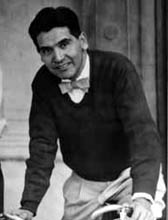
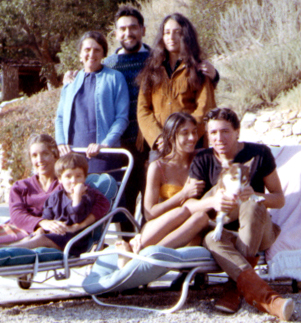
March 24, 2007
The garden is starting to look really nice. Roses and agave:


March 25, 2007
A while back James Dolan told me a bit about
thermophiles:
organisms that like it hot.
Which ones can take the most heat? Among hyperthermophiles, it seems the winner is Pyrolobus fumarii, a microbe of the domain Archaea which lives in hydrothermal vents at the bottom of the Atlantic — at a temperature of 113° C! Yes, that's above the boiling point of water, at least at ordinary pressures. But down there it's not, because the pressure is so high!
In hydrothermal vents, water easily reaches 350° C while remaining liquid. As of 2006, the record temperature for hydrothermal vents was 407° C, observed at a depth of 3000 meters. his is fascinating because at such high temperatures and pressures water is supercritical: there's no sharp distinction between liquid and gas!
Can any life survive those temperatures?
Among higher organisms, it seems the Sahara desert ant is the winner. From Wikipedia:
While no known animal can live permanently at a temperature over 50°C, Sahara desert ants can sustain a body temperature well above 50°C with surface temperatures of up to 70°C.But, I was reminded to write about these heat-lovers only because the science reporter Davide Castelvecchi sent me a list of his top 10 science stories of 2006, which included one on critters that like it cold! Believe it or not, there are bacteria that can live in liquid nitrogen. Castelvecchi wrote:This ant ventures far from its burrow in the Sahara desert, which has almost no identifiable features, to find food. While venturing out it periodically takes measurements of its angle in respect to the Sun. By doing this the ant can venture far from its nest in search of food. Because of the blistering heat, it can only do this for about 3-5 minutes/day (the hottest time of the day, when all its predators are in hiding from the sun). When the ant finds a dead insect it then looks at the sun and because of its periodic references to the sun's angle it knows exactly what the shortest route back to the nest is.
As I was reading New Scientist last August — the issue with my cover story, as it happens — I stumbled into this tale, told by my friend Douglas Fox. The tale's hero goes by the unlikely name of Colwellia psychrerythraea 34H.There are "obligate thermophiles" that can't survive below 60° C. Colwellia is an "obligate psychrophile" - it requires temperatures below 20° to grow on solid media.Colwellia is one of those bugs that have been found, alive and kicking, trapped down deep in the ice of Antarctica. Karen Junge, a microbiologist at the University of Washington in Seattle, was studying Colwellia in her lab's freezers, trying to understand how it manages to survive at -20 degrees Celsius.
To check out the bug's metabolism at those temperatures, Junge measured how fast it absorbed an amino acid compared with specimens kept at -80 degrees, where no metabolism would occur. Something was wrong, though: the metabolism of her control specimens didn't stop. So Junge tried sticking them in liquid nitrogen. Even there, at -196 degrees, Colwellia kept eating up the amino acid, a sign that it was still biologically active.
If you like this stuff, try reading about other extremophiles.
March 29, 2007
Speaking of extremophiles, my pal Miguel Carrión Álvarez points
out the charms of
Deinococcus radiodurans!
© 2007 John Baez
baez@math.removethis.ucr.andthis.edu